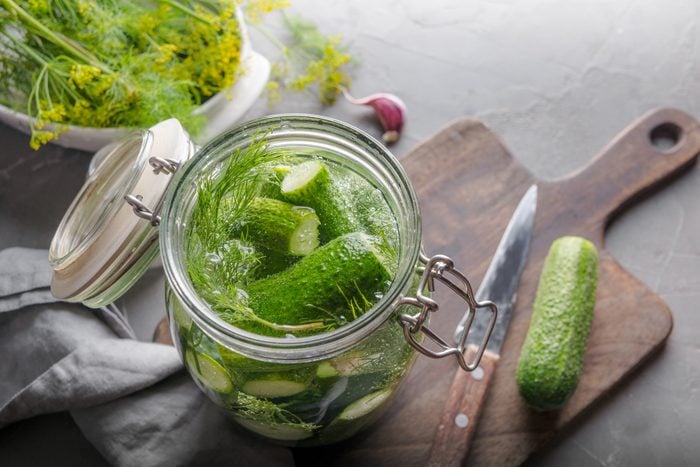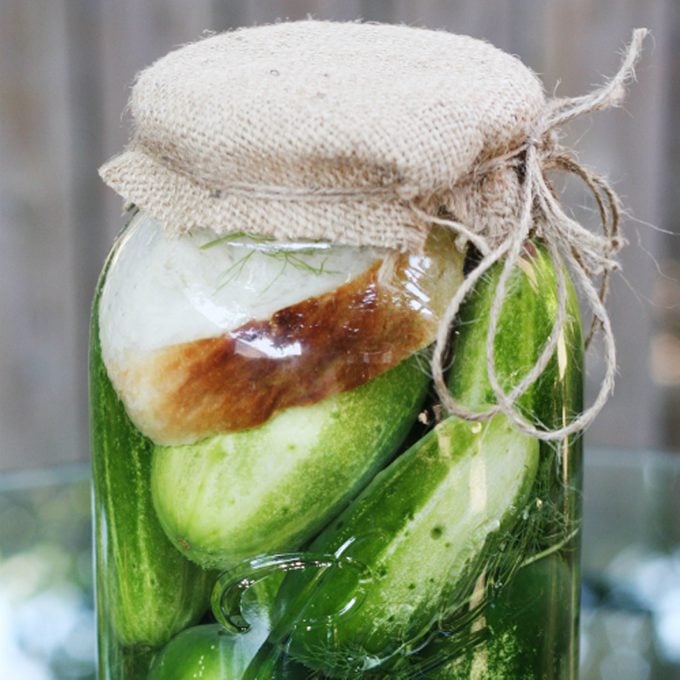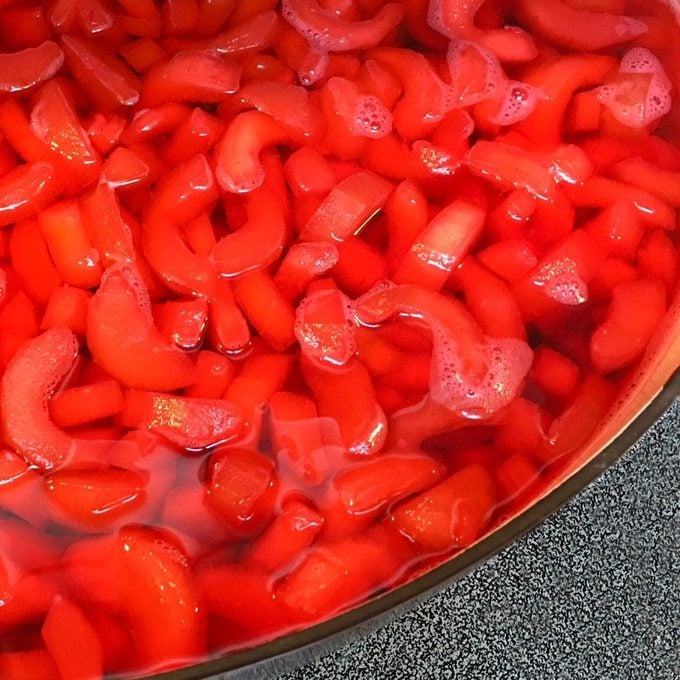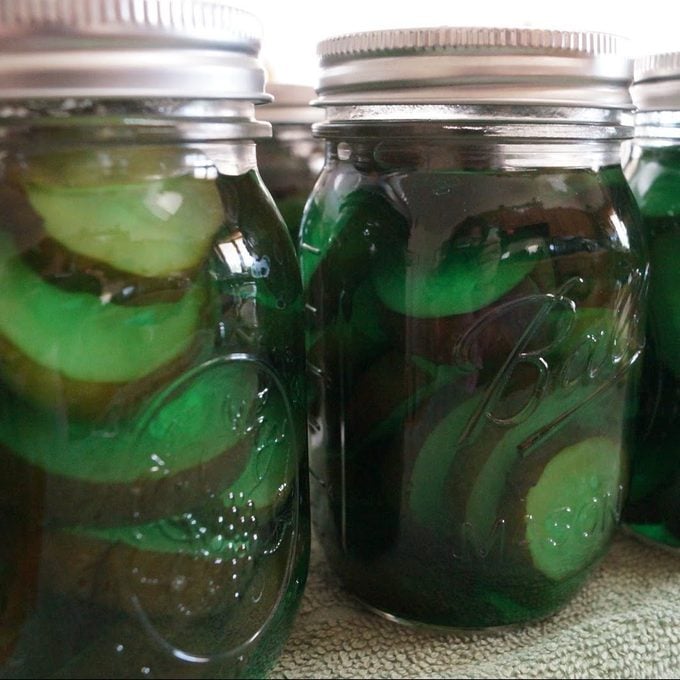It’s a great year to grow some cucumbers, especially if you’re a fan of pickles. Growing cucumbers is easy, and you’ll be rewarded with a huge crop—but do you know the best cucumbers for pickling?
The first year I made pickles from my garden cucumbers, I assumed any type would work just fine in the brine. Big mistake: I ended up with disappointing pickles that had tough skins and mushy centers. It turns out there really is a reason why some cucumbers are meant for slicing and snacking, and others are meant for making pickles.
Our step-by-step guide has all you need to know. You can also discover if pickles are good for you!
What Makes a Cucumber Good for Pickling?
What if I want to eat my cucumbers and pickle them, too? Technically, can’t any type of cucumber be pickled?
The reason certain varieties are considered better for pickling is that, in the end, they make better-tasting pickles. According to Angela Gerace, who creates award-winning pickles at her company The Tipsy Pickle, the best pickling cucumbers should have thin skins. (This is rare in most grocery store cucumbers.)
While you’re at it, check out the moonshine pickle that actually makes you tipsy!
- Thin skin: “The thicker the skin, the harder for the brine to really get absorbed,” she says. “Thin is better.”
- Firm, dry flesh: Angela also notes that pickling cucumbers should have firmer and drier flesh, which stays crunchy even after a long brine.
- Small size: Cucumbers bred specifically for pickling are shorter: anywhere from 1-1/2 to about 6 inches long. They also have squatter shapes with ends that are blunt instead of pointed—this allows whole and spear-cut cucumbers to be packed snugly into jars. (Which shape you choose might depend on the type of pickle you crave.)
The Best Pickling Cucumber Varieties
We’ve rounded up some of the most popular types of pickling cucumbers, including options for larger gardens, small plots and container gardens. (First-time grower? Be sure to check out our beginner’s guide to growing veggies.)
No matter the type, all cucumbers prefer full sun and consistent watering. The plants cannot tolerate any cold snaps, so wait until all danger of frost has passed before sowing your seeds. Pick cucumbers often to keep the plants producing and to avoid oversize, bitter fruits. Use these cucumber recipes if you need recipe ideas beyond pickles.
Boston Pickling
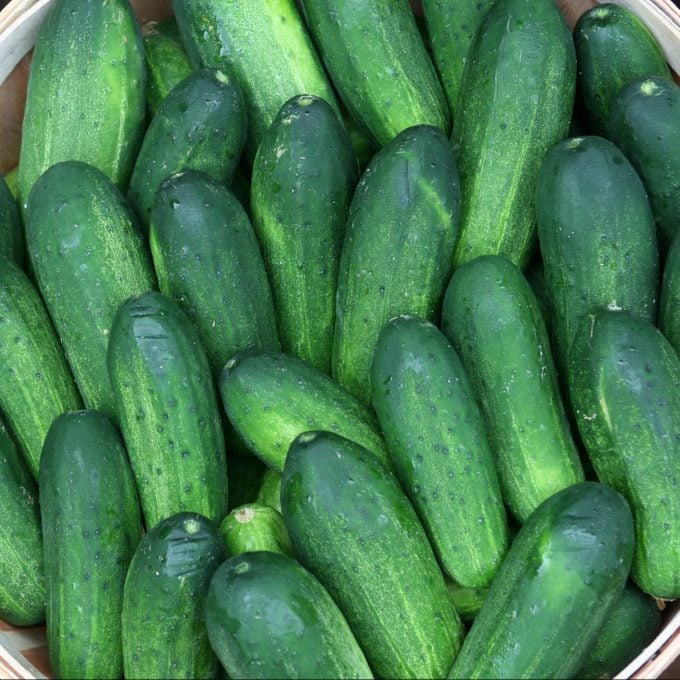 Boston Globe/Getty Images
Boston Globe/Getty Images
- Plant type: heirloom, vining
- Days to maturity: 55
- Size: 3-inch fruits
- Disease resistance: downy mildew, powdery mildew, scab, angular leaf spot
- Plant spacing: 12 inches
Boston Pickling has been a favorite of gardeners for more than a century because it produces cucumbers continuously throughout the growing season. The flesh is firm, crunchy and holds a lot of flavor from the brine. This is Angela’s pickling pick.
Shop Now
Bush
 Fordvika/Getty Images
Fordvika/Getty Images
- Plant type: hybrid, bush
- Days to maturity: 50
- Size: 4- to 5-inch fruits
- Disease resistance: scab, cucumber mosaic virus
- Plant spacing: 18 inches or 1 plant per container
With this compact variety, as long as you have sun, you can grow tons of cucumbers in even the tiniest spaces or containers. Although its growing season is shorter than other, non-compact types, you can solve this by planting more continuously over the season (aka “succession planting”).
Shop Now
Calypso
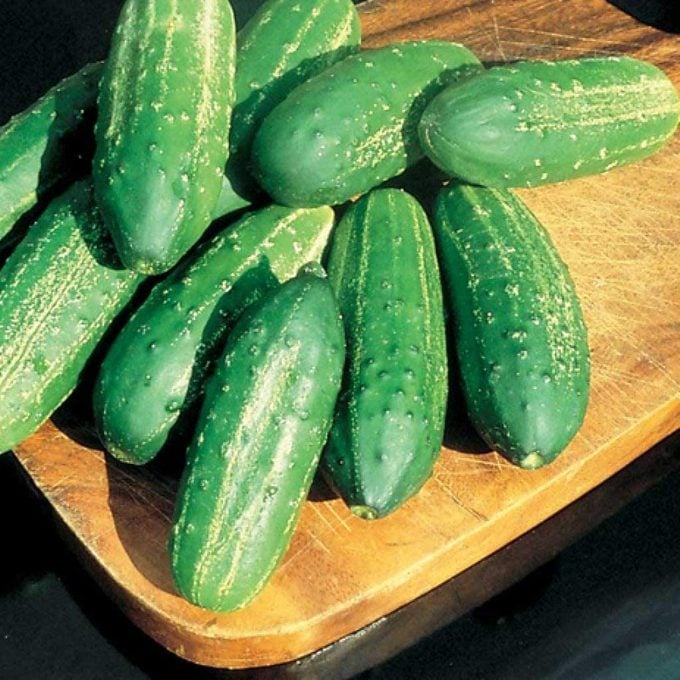 via merchant
via merchant
- Plant type: hybrid, vining
- Days to maturity: 52
- Size: 4-inch fruits, 1 inch in diameter
- Disease resistance: angular leaf spot, anthracnose, cucumber mosaic virus, powdery mildew, scab
- Plant spacing: 12 inches
Calypso is a high-yielding pickling cucumber that is especially prized for its disease resistance. The fruits have firm interiors that make them great for eating fresh as well as pickling. Grow these vining plants on a trellis for easier access.
Shop Now
H-19 Little Leaf
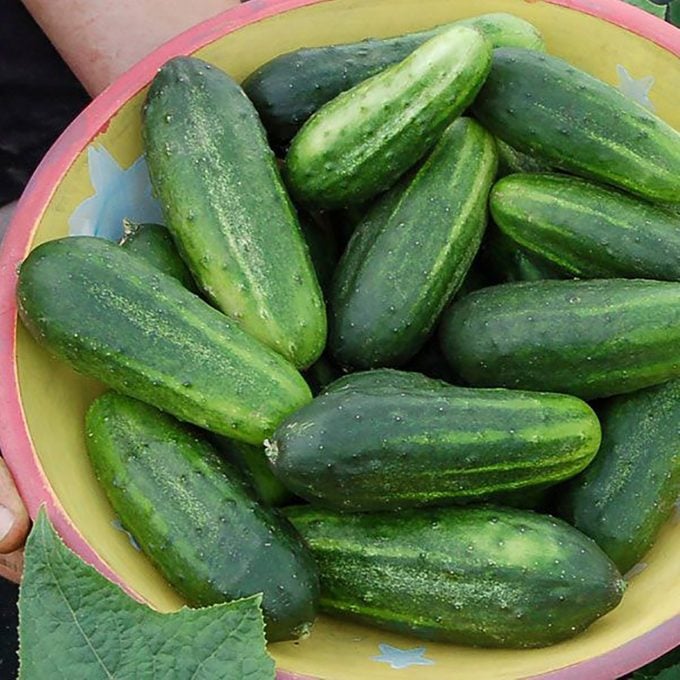 via merchant
via merchant
- Plant type: nonhybrid, compact, multi-vining
- Days to maturity: 58
- Size: 3- to 4-inch fruits
- Disease resistance: angular leaf spot, anthracnose, scab, cucumber mosaic virus, powdery mildew
- Plant spacing: 12 inches
This pickling cucumber is a great choice for small gardens or containers. As the name suggests, this plant has smaller leaves and grows fruit from multiple vining branches, which makes harvesting easy. Despite its small size, H-19 produces lots of cucumbers.
Shop Now
National Pickling
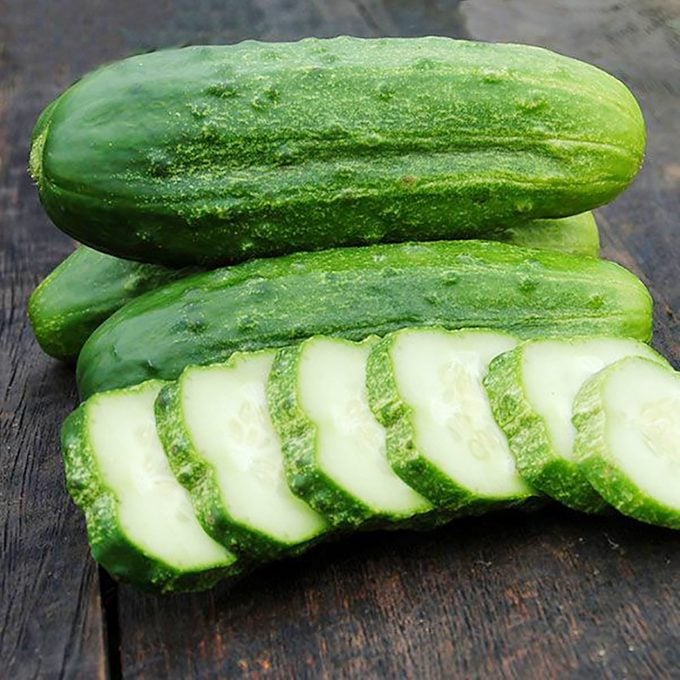 via merchant
via merchant
- Plant type: heirloom, vining
- Days to maturity: 52
- Size: 5-inch fruits
- Disease resistance: cucumber mosaic virus, scab
- Plant spacing: 8-12 inches
Developed by the National Pickle Packers Association, this cucumber variety produces abundantly throughout the season. The cucumbers are short, thick and perfectly shaped for packing into jars. The 3- to 4-foot vines can grow upright on a trellis or along the ground.
Shop Now
Wisconsin SMR 58
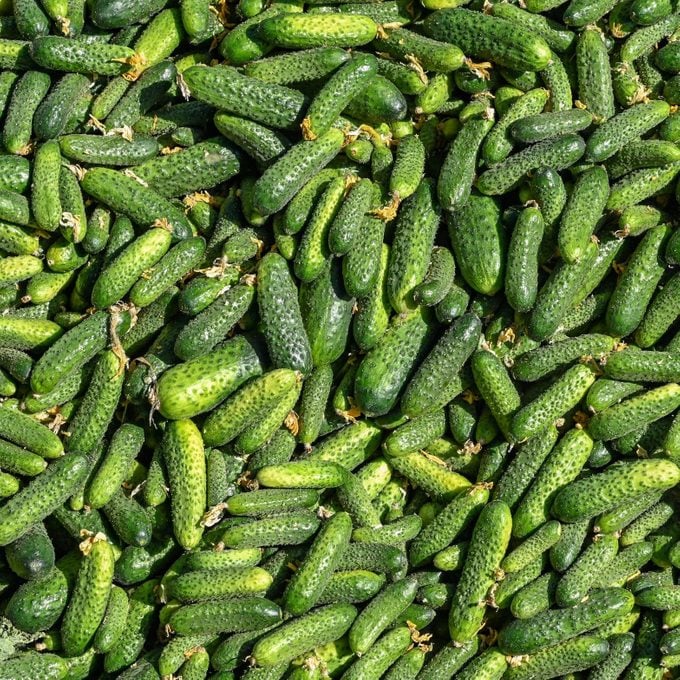 picture alliance/Getty Images
picture alliance/Getty Images
- Plant type: nonhybrid, vining
- Days to maturity: 55-60
- Size: 6- to 8-inch fruits
- Disease resistance: scab, cucumber mosaic virus
- Plant spacing: 12-24 inches
This pickling cucumber variety was bred at the University of Wisconsin. It’s a favorite of midwestern gardeners and picklers because the plants are such heavy producers. SMR 58 is a great choice to grow on a trellis, not only to make harvesting easier but also so cucumbers will grow straight and fit better inside canning jars.
Shop Now
Tips for Picking the Best Pickling Cucumbers
Does it matter what size the cukes are?
When it’s time to pickle, select pickling cucumbers from your harvest that are similar in size. That way they’ll brine at the same rate and fit well together into canning jars.
When should I pick cucumbers?
Pickling cucumbers are meant to be picked when still small, for the best flavor and to fit into jars. Check the description on the cucumber seeds you planted to confirm their size at maturity, and pick them often.
When ripe, cukes are firm and have good color. If picked too early, cucumbers may not stay firm after brining. But, because the fruits grow so fast, the more common problem is too-large, overripe cucumbers. When in doubt, taste test. If it’s bitter, spongy or has very hard seeds, it’s overripe and should be composted.
What if I’m not a gardener? What should I look for when buying pickling cucumbers?
The best place to purchase pickling cucumbers is a farmers market, produce stand or local farm. The cucumbers will not only be fresher but also free of waxy coatings found on cucumbers shipped across the country. They may also be organic and free of pesticides. Be sure to choose pickling cucumbers and not slicers. (In stores, they’re often labeled as Kirbys. At the market, ask the farmer!) Make sure they’re all the same size, and choose smaller ones from the bin to be sure they’re not bitter.
Types of Pickles You Need to Know
 Taste of Home
Taste of HomeWhat Are Dill Pickles?
Dill pickles are the most popular type of pickle. They are, quite simply, brined cucumbers flavored heavily with dill. And
pickle recipes for dill vary: Some include garlic,
pickling spice or even spicy peppers. All, though, rely upon dill whether fresh, dried or in seed form.
If you'd prefer store-bought to homemade, try our Test Kitchen's
favorite dill pickles. You'll find plenty of dill options in the grocery aisle:
moonshine pickles, whole, spears, chips, slices —every iteration imaginable. No matter the slice, dill pickles go well on burgers, Chicago-style hot dogs or even a plain pickle on a stick like you'd eat at the fair.
Find out
if pickles are good for you!
 John Block/Getty Images
John Block/Getty ImagesWhat Are Kosher Pickles?
Just like
Kosher salt, Kosher pickles aren't necessarily Kosher in terms of preparation. The term here refers to a style of pickling using a salt brine (made with Kosher salt, of course) and generous amounts of garlic and dill. While dill pickles
may have garlic, Kosher pickles
need to have garlic—it's part of the traditional recipe. That's what makes them different!
If you've ever wondered
why pregnant women crave pickles, it could be because the salt causes the body to retain fluid, thus staving off dehydration. Pregnant or not, though, the salty brine of Kosher pickles is hard to beat. Pair quartered spears with crispy
fried chicken thighs, serve a whole spear with a classic sub sandwich or eat slices straight out of the jar.
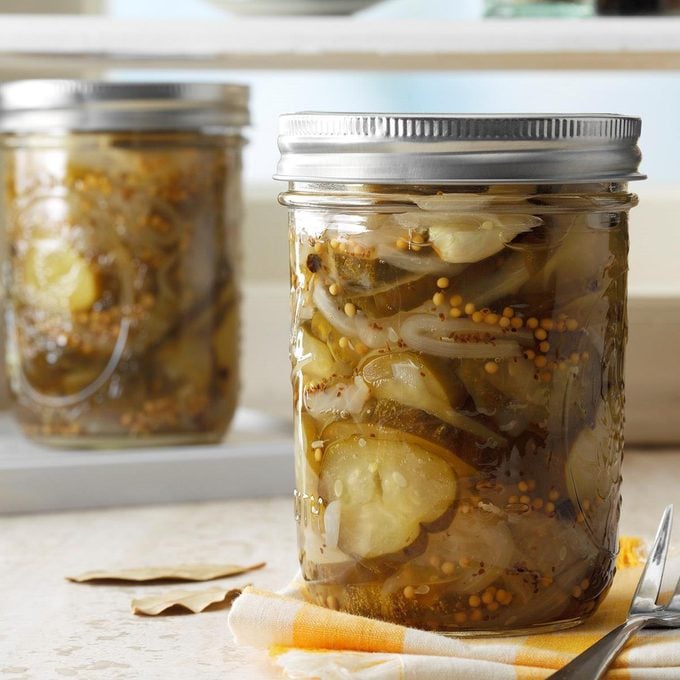 Taste of Home
Taste of HomeWhat Are Sweet Pickles?
The
best cucumbers for pickling have thin skin. If you can find those in your grocery store or in your garden, you can make your own
sweet pickles with a brine containing sugar. The brine gives these pickles just a touch of sweetness (don't worry—these types of pickles aren't candy-sweet).
Recipes vary and call for all sorts of spices and aromatics. All recipes for sweet pickles, though, will call for vinegar, sugar and—quite often—thinly sliced onion. To really allow the brine to absorb, you'll want to cut the cucumbers into slices rather than brining them whole. Once they're ready to eat, add sweet pickles to fresh green salads,
potato salads or lunch sandwiches.
 Taste of Home
Taste of HomeWhat Are Bread and Butter Pickles?
Despite the name, bread and butter pickles don't taste like bread or butter. These thinly sliced pickles are actually a type of sweet pickle thanks to the sugar used in the brine. The name "bread and butter" comes from a farming couple who wanted to trademark the name for their signature pickles back in the 1920s.
Today,
bread and butter pickles walk that perfect line between sweet and sour. The brine calls for plenty of vinegar as well as sugar to get that just-right mix. These recipes typically call for mustard seed and celery seed, too, but as with any pickle, there are lots of delicious variations.
Bread and butter pickles will go well with the same types of food you'd pair with sweet pickles. They'll also add great flavor to burgers or tuna salad, and can be chopped into relish to use in
Southern deviled eggs or on hot dogs.
 merc67/Getty Images
merc67/Getty ImagesWhat Are Sour Pickles?
The
health benefits of fermentation are still being researched, but the probiotics formed in the process could aid in digestion and help strengthen our immunities. Sour pickles are a great source of fermented food. They are made in a vinegar-less brine and fermented in a mix of water,
pickling salt and spices. When eaten within the first six weeks of fermenting, these pickles are called half-sour. After that, you'll find them
canned and called sour pickles.
Unlike other pickles, they don't have that vinegar bite or sweetness. Quite simply, they're sour! Enjoy them with brats, on
charcuterie boards or on burgers.
 JMichl/Getty Images
JMichl/Getty ImagesWhat Are Gherkin Pickles?
A gherkin is a small
variety of cucumber. They are bumpier than their traditional cucumber cousins and are picked and pickled whole while quite small—typically under two inches long. You can grow these plants yourself or buy gherkin pickles right at the store. They may be advertised as petite or baby dills. Serve them on a beautiful
crudités platter for a party or on a
relish tray like you'd see at an old-fashioned supper club.
 IgorGolovnov/Getty Images
IgorGolovnov/Getty ImagesWhat Are Cornichons?
Cornichons and gherkins are the same thing! You'll often hear these petite pickles referred to as cornichons in
French recipes. Use the terms interchangeably.
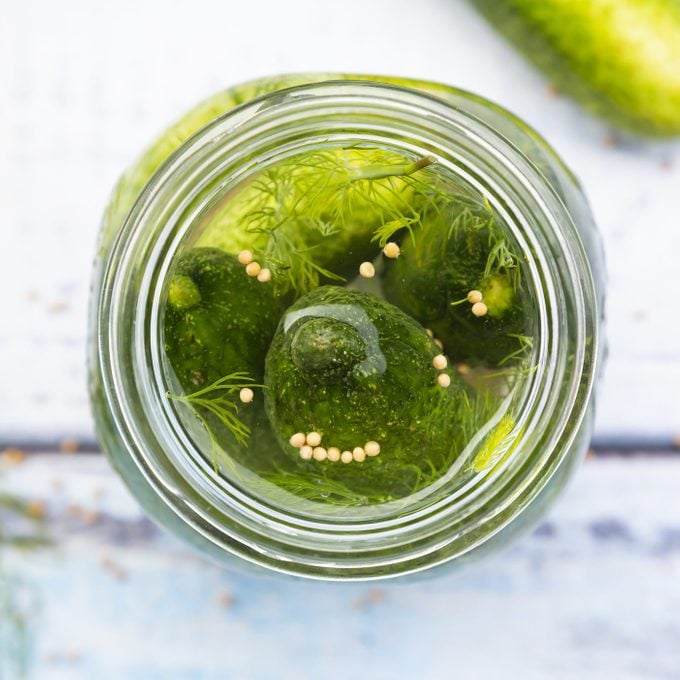 Westend61/Getty Images
Westend61/Getty Images
What Are Polish/German Pickles?
Polish or German pickles are similar to dill pickles but usually involve herbs and spices like caraway seeds, mustard seeds and/or peppercorns. The extra spices add a kick you won't usually find in other types of pickles. These are also usually pickled in wooden barrels for a distinctive taste, though they're sold in glass jars. Learn how to make this delicious
mustard pickle relish or sliced the hot pickles into potato salads, chicken salads or egg salads for added heat.
What Are Hungarian Pickles?
Hungarian pickles, also known as
kovaszos uborka, are unique because they actually use
bread to help along the pickling process (maybe they should be the new bread and butter pickles?). Though you won't find bread to be part of the typical guide to pickling, the yeast in the bread does the job of pickling in the place of vinegar. Fresh cucumbers are put in a glass with water, salt and spices; topped with a slice of stale bread and then left out in the sun.
Serve Hungarian pickles simply on a slice of fresh bread spread with butter or on the side of hearty meat dishes like
Hungarian goulash.
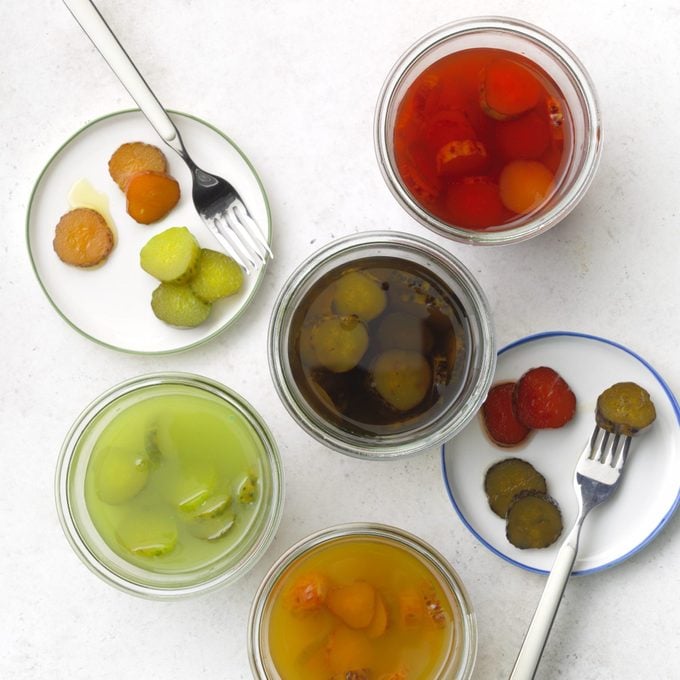 TMB Studio
TMB Studio
What Are Kool-Aid Pickles?
Kool-Aid pickles are exactly what they sound like—pickles infused with a healthy dose of Kool-Aid powder, vinegar and sugar. Learn
how to make the TikTok Kool-Aid pickles or try the hot
Chamoy pickles brined in sweet candy powder and hot sauce if you like a bit more kick than Kool-Aid. Eat them whole right out of the jar!
What Are Cinnamon Pickles?
Another Southern creation, cinnamon pickles involve not just cinnamon sticks, but also Cinnamon Red Hot candy. The pickling solution is about what you'd expect for sweet pickles, except for this, you'd also add a bunch of cinnamon sticks and Cinnamon Red Hot candy. Many recipes also call for red food coloring to get the look just right. Enjoy them just like you would a piece of candy—pop the slices right out of the jar and into your mouth.
What Are Lime Pickles?
Nope, there are no citrusy limes involved here—the lime refers to pickling lime, a white chemical powder that was used in old canning recipes to add a dash of crispness to the finished product. However, this method isn't recommended any longer, because it can make you very sick!
The pickling lime itself isn't the problem. Vinegar, which is usually used in pickling, is acidic and kills off bacteria. Leaving too much pickling lime, an alkaline substance, before canning can neutralize the acidity and allow bacteria to grow.
 TMB studio
TMB studioWhat Are Refrigerator Pickles?
Making
refrigerator pickles is a quicker way to preserve vegetables. This quick method doesn't require the preciseness of traditional canning or a lot of the gear (though you'll still want a few
canning supplies to help you along).
Refrigerator pickles are made by soaking fresh veggies in a brine of vinegar and spices. You pop the veggies and brine into jars, cover them and store in the refrigerator. This type of pickling isn't shelf-stable—you'll have to keep your makes in the fridge and eat them within a few weeks. And in reality, any variety of
pickles need to be refrigerated if the jar has been opened.
